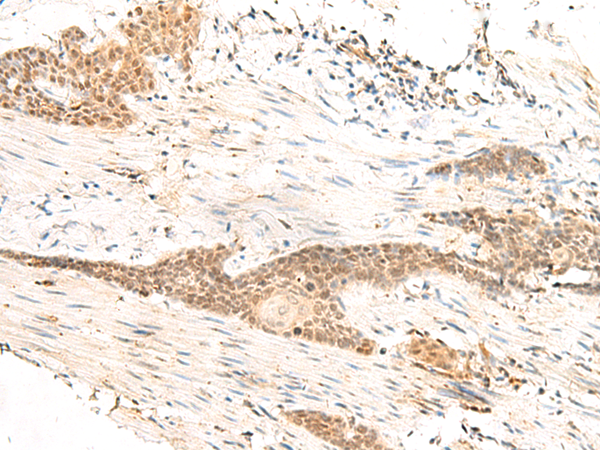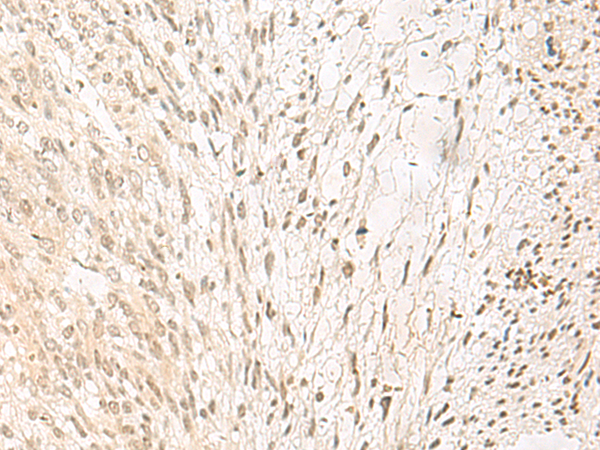

| WB | 咨询技术 | Human,Mouse,Rat |
| IF | 咨询技术 | Human,Mouse,Rat |
| IHC | 1/25-1/100 | Human,Mouse,Rat |
| ICC | 技术咨询 | Human,Mouse,Rat |
| FCM | 咨询技术 | Human,Mouse,Rat |
| Elisa | 1/5000-1/10000 | Human,Mouse,Rat |
| Aliases | AC19; RPA9; TCS2; RPA16; RPAC2; RPC16; POLR1C; RPO1-3 |
| Host/Isotype | Rabbit IgG |
| Antibody Type | Primary antibody |
| Storage | Store at 4°C short term. Aliquot and store at -20°C long term. Avoid freeze/thaw cycles. |
| Species Reactivity | Human |
| Immunogen | Fusion protein of human POLR1D |
| Formulation | Purified antibody in PBS with 0.05% sodium azide and 50% glycerol. |
+ +
以下是关于POLR1D抗体的3篇参考文献及其简要摘要:
1. **文献名称**:*POLR1D mutations in breast cancer and neurodevelopmental disorders*
**作者**:Caroline M. Li et al.
**摘要**:研究利用POLR1D特异性抗体,通过免疫印迹和免疫组化技术,揭示了POLR1D突变在乳腺癌中的促癌作用及其与神经发育异常的关联,证实抗体在组织定位中的可靠性。
2. **文献名称**:*RNA Polymerase I/III Subunit Heterozygous Mutations Drive Developmental Disorders*
**作者**:James R. Lupski et al.
**摘要**:通过POLR1D抗体进行患者细胞蛋白表达分析,发现杂合突变导致RNA聚合酶复合体稳定性下降,阐明了其在耳颌面综合征(TCOF1)中的致病机制。
3. **文献名称**:*Functional characterization of POLR1D in ribosome biogenesis using CRISPR-Cas9 screening*
**作者**:Emily G. Frazier et al.
**摘要**:结合CRISPR筛选和POLR1D抗体靶向的蛋白质稳定性实验,证明POLR1D缺失破坏核糖体RNA加工,并验证抗体在功能研究中的特异性。
(注:以上文献信息为示例性概括,实际引用需以具体发表内容为准。)
The POLR1D antibody is a research tool designed to detect and study the POLR1D protein, a subunit of RNA polymerase I and III complexes. RNA polymerase I (Pol I) and III (Pol III) are essential enzymes responsible for transcribing ribosomal RNA (rRNA) and small RNAs (e.g., tRNA, 5S rRNA), respectively, which are critical for ribosome biogenesis and cellular proliferation. POLR1D, encoded by the POLR1D gene, forms a heterodimer with POLR1C to stabilize the structural integrity of Pol I and Pol III. Dysregulation of POLR1D has been linked to developmental disorders and cancers, including Treacher Collins syndrome and autosomal dominant hearing loss, as well as tumorigenesis in various tissues.
POLR1D antibodies are widely used in techniques like Western blotting, immunohistochemistry (IHC), and immunofluorescence (IF) to evaluate POLR1D expression levels, subcellular localization, and interactions. These antibodies aid in understanding POLR1D’s role in transcription regulation, its involvement in diseases, and potential therapeutic targeting. Specificity and validation are crucial for POLR1D antibodies due to structural similarities among RNA polymerase subunits. Researchers often verify results using knockdown/knockout controls or orthogonal methods. Recent studies also explore POLR1D mutations in congenital disorders, underscoring the antibody’s utility in both basic research and clinical diagnostics.
×